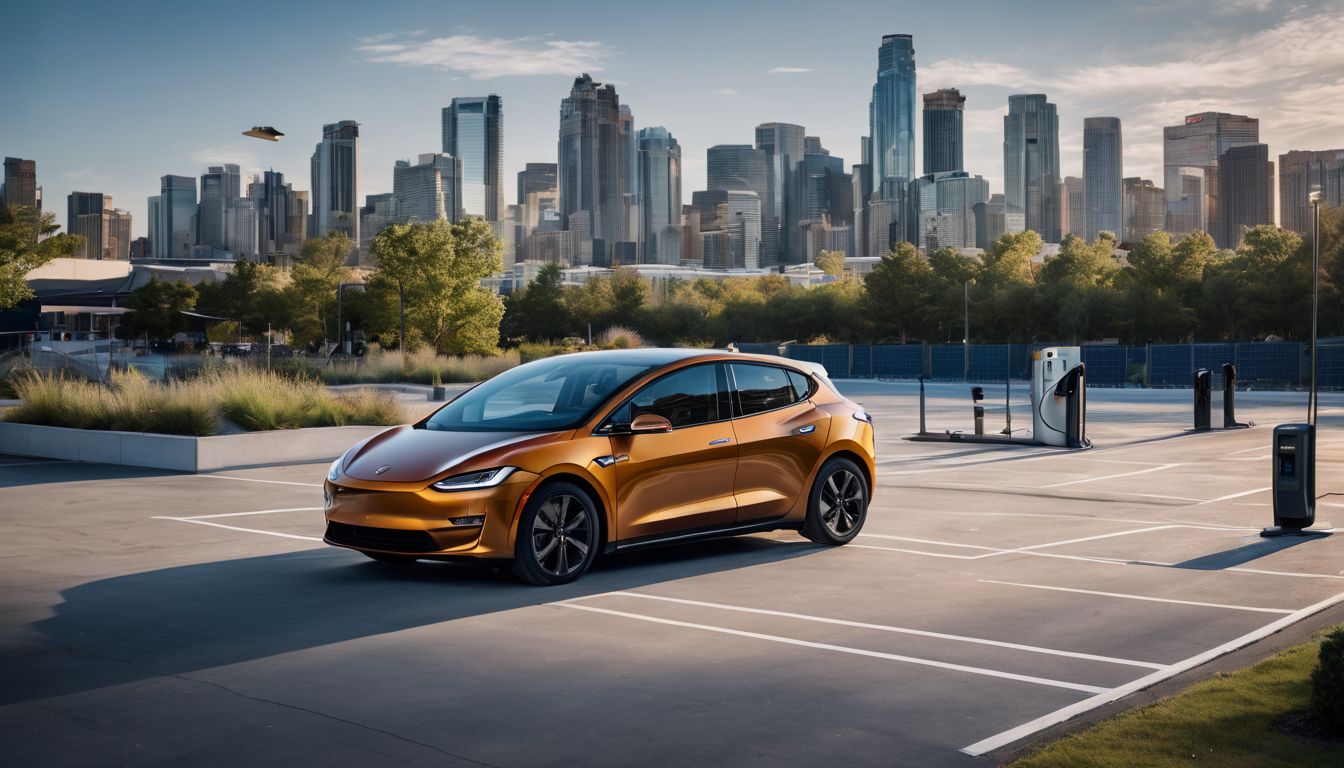Electric vehicles (EVs) are poised to redefine the avenues of travel, yet their journey is speckled with a fair share of obstacles. Much like you, we’ve clocked these speed bumps – from the hefty price tags to the niggling anxieties over charging networks – and it’s patently obvious that solutions can’t come soon enough.
As we delve into this exploration, our commitment is to meet these challenges square on, sharing insights as we collectively steer towards an electrified future. So stay tuned; change isn’t just coming—it’s practically at our doorstep!
Key Takeaways
- Electric vehicles face high costs due to limited affordable models and insufficient government subsidies, which prevents wider adoption.
- Range anxiety is a common concern for potential EV owners because of inadequate charging infrastructure, variable charging speeds, and compatibility issues with different chargers.
- The availability of skilled technicians and a diverse range of electric vehicle models are limited, making it harder for consumers to find suitable options that meet their needs.
- Necessary upgrades to grid capacity and infrastructure are needed to support the growing number of electric vehicles, particularly in rural areas where exposure to EVs is less common.
- Planning and permitting for new charging stations involves high costs and extensive coordination between multiple parties, creating additional hurdles in developing widespread EV-compatible infrastructure.
High Purchase Cost
High Purchase Cost: The limited availability of affordable electric vehicle options and the lack of government subsidies have contributed to the high purchase cost, making it less accessible for a wider market.
Limited availability of affordable options
We face a significant hurdle in increasing electric vehicle adoption due to the limited range of affordable options. Many environmentally conscious consumers are eager to transition from traditional combustion engines to cleaner electric cars, yet the high entry price for EVs remains a barrier.
The market currently leans towards higher-end models with advanced features that push up costs, leaving those of us on tighter budgets with few choices.
Manufacturers need to broaden their offerings and introduce cost-effective electric vehicles that don’t compromise quality or performance. We recognise this as an essential step towards sustainable transportation, helping reduce carbon emissions and our reliance on fossil fuels.
As demand grows and battery technology improves, we anticipate more affordable EVs will hit the road, making it easier for everyone to play a part in environmental conservation.
Lack of government subsidies
Government subsidies are lacking, hindering the widespread adoption of electric vehicles. Without these incentives, the purchase cost of EVs remains high, creating a barrier for many potential buyers.
Subsidies could significantly reduce this upfront expense and make electric vehicles more accessible to a wider range of consumers. Additionally, government support is crucial in developing comprehensive charging infrastructure and renewable energy sources to power these vehicles sustainably.
The absence of subsidies also impacts the automotive industry’s growth potential as it discourages investment in EV technology and production. With government encouragement and financial aid, the industry could accelerate innovation and scale production, ultimately driving down costs for both manufacturers and consumers.
Range Anxiety
Insufficient charging infrastructure and varying charging speeds and compatibility contribute to range anxiety in electric vehicles. This challenge can deter potential buyers from making the switch to electric vehicles.
Insufficient charging infrastructure
To overcome the challenge of insufficient charging infrastructure for electric vehicles, we must invest in expanding the network of charging stations. This expansion should include more public locations and workplaces to enhance accessibility for individuals with limited home charging options.
Developing a reliable, widespread charging infrastructure is crucial to alleviate range anxiety and encourage more people to make the switch to electric vehicles. Furthermore, ensuring that these chargers are compatible with different models and provide fast-charging capabilities will significantly improve the convenience and appeal of electric vehicles.
Charging speeds and compatibility
Transitioning from insufficient charging infrastructure to the topic of charging speeds and compatibility, it’s essential to consider how these factors impact our choice of electric vehicles.
When enquiring about EVs, understanding the range and speed at which they charge is crucial. Compatibility with various types of chargers can also affect our ability to keep them charged effectively.
EV manufacturers are striving to improve charging technology continuously; nevertheless, current limitations mean that not all EVs can be rapid-charged on every charger. Therefore, considering this when purchasing an EV is vital for ensuring seamless integration into your lifestyle.
Limited Selection and Technician Availability
Finding knowledgeable technicians for electric vehicles can be a challenge, and the limited availability of models and brands makes it difficult to find the right fit for individual needs.
Difficulty in finding knowledgeable technicians
Finding a knowledgeable technician for electric vehicles can be challenging. It requires specialised training and expertise to work on EVs, but finding technicians with this knowledge may be limited in some areas.
This scarcity can lead to longer wait times for servicing or repairs, frustrating environmentally conscious individuals who want to support clean energy transportation options. Additionally, the lack of skilled technicians might result in higher service costs due to the high demand and low supply of qualified professionals.
Moving forward, let’s address the impact of limited availability of models and brands in the electric vehicle industry.
Limited availability of models and brands
Electric vehicle consumers face limited availability when it comes to choosing from different models and brands. This can be frustrating for those looking to make a shift to electric vehicles but are unable to find suitable options that meet their needs.
The lack of variety in the market also makes it challenging for consumers to find an electric vehicle that aligns with their preferences, lifestyle, and budget.
Developing a more diverse range of electric vehicle models and brands is crucial in catering to the varying needs and tastes of potential buyers. It’s important for manufacturers to expand their offerings, making environmentally friendly transportation accessible and appealing across the board.
Grid Capacity and Infrastructure Challenges
Upgrades are needed to support the growth of electric vehicles, and there are high costs and coordination required for planning and permitting charging stations. Additionally, rural areas with limited exposure to EVs face unique challenges in terms of infrastructure development.
Upgrades needed to support EV growth
- Enhancing power distribution networks to handle increased demand from charging stations.
- Implementing smart grid technology to manage and optimise energy flow for EV charging.
- Ensuring grid stability and reliability through investments in energy storage systems.
- Expanding renewable energy generation capacity to meet the additional power demands from electric vehicles.
- Developing dynamic pricing models to encourage off-peak charging and reduce strain on the grid during peak times.
High costs and coordination for charging station planning and permitting
The high costs and coordination required for charging station planning and permitting pose significant challenges to the electric vehicle industry.
- Setting up a charging station can involve high initial costs, including land acquisition, infrastructure installation, and equipment procurement.
- Coordinating with local authorities and utility companies for permits and approvals can lead to delays and additional expenses.
- Developing charging infrastructure often requires collaboration between public and private entities, which may result in complex negotiations and resource allocation.
- The financial investment needed for the deployment of charging stations across various locations can be substantial, impacting the scalability of EV infrastructure.
- Securing funding for charging station development may require navigating through diverse financing options, grants, and incentives available from governmental or private sources.
Challenges in rural areas with limited exposure to EVs
Rural areas with limited exposure to EVs pose challenges for the widespread adoption of electric vehicles. The lack of charging infrastructure in remote regions makes it difficult for residents to charge their EVs conveniently.
Furthermore, limited access to knowledgeable technicians hinders the maintenance and repair of electric cars in these areas. Addressing these challenges is crucial in ensuring that all communities have equal opportunities to embrace sustainable transportation.
Grid capacity and infrastructure must be improved in rural areas to support the growth of EV usage. Additionally, efforts should be made to provide education and exposure about EV technology and benefits within these communities.
Conclusion
In conclusion, the electric vehicle industry faces significant challenges. Limited availability of affordable options and lack of government subsidies contribute to high purchase costs.
Range anxiety persists due to insufficient charging infrastructure and slow charging speeds. Finding knowledgeable technicians and limited model availability also pose obstacles. Additionally, upgrades are needed for grid capacity, especially in rural areas with minimal exposure to EVs.
FAQs
1. What are the main challenges facing the electric vehicle industry?
The electric car industry faces several challenges, including developing sufficient EV infrastructure, installing enough charging stations, and making sure vehicles are both cost-effective and energy-efficient.
2. Why is it hard to find a technician for electric vehicles?
Electric vehicle technology is complex and new, which creates a shortage of trained technicians who can service these cars and handle their unique issues.
3. How do rural areas affect the growth of the electric vehicle market?
Rural infrastructure often lacks adequate EV charging stations, making long trips difficult for electric car owners and slowing down widespread adoption across less urbanised regions.
4. Are there any environmental concerns with electric vehicles?
Despite being environmentally friendly in operation, challenges remain regarding the environmental impact of manufacturing EVs and ensuring they’re more energy-efficient throughout their whole life cycle.
5. Do high costs influence people’s decision to buy an electric vehicle?
Yes, one of the significant hurdles within the EV market includes addressing the higher upfront costs associated with purchasing an electric car compared to traditional petrol or diesel vehicles.





